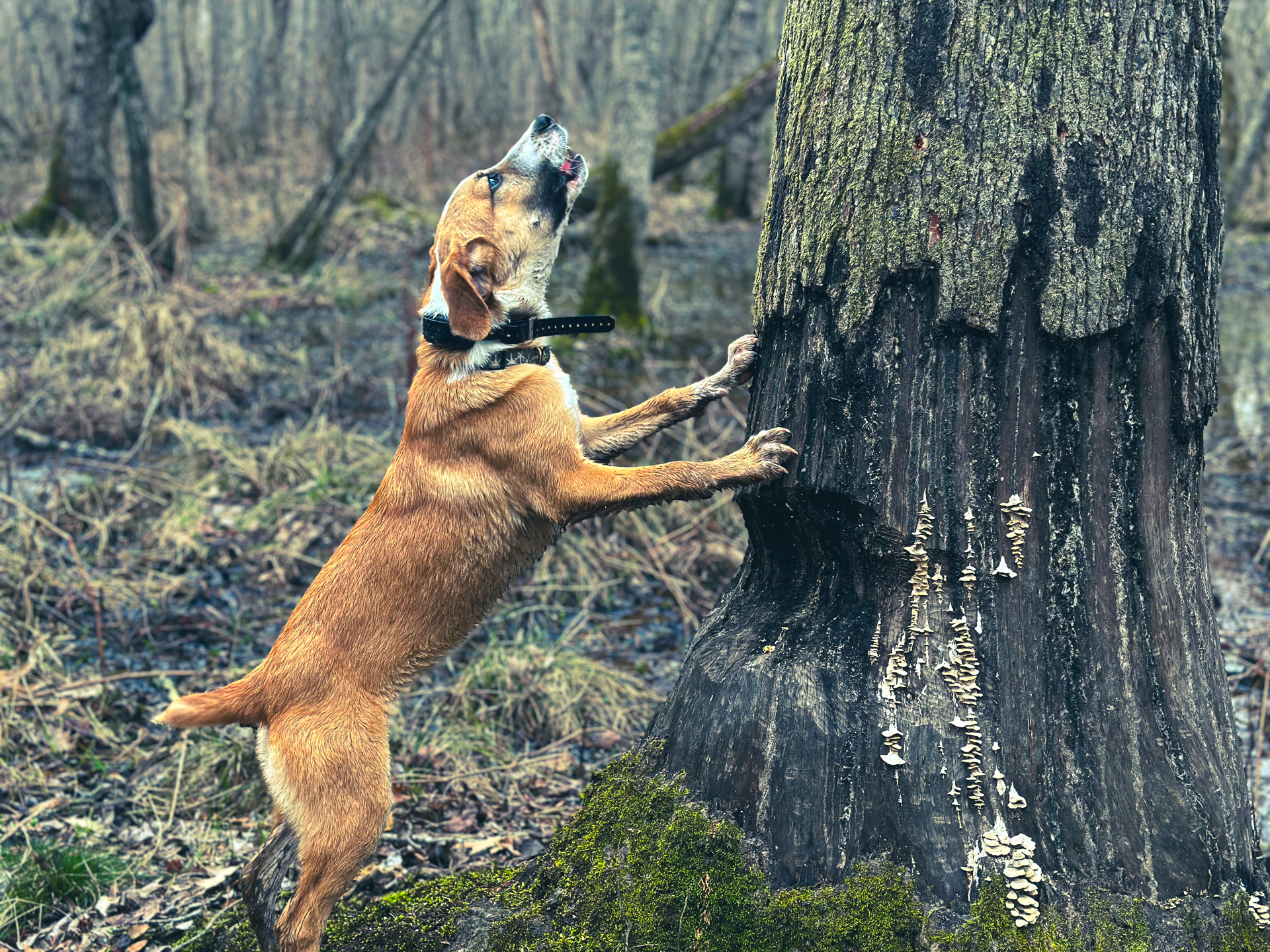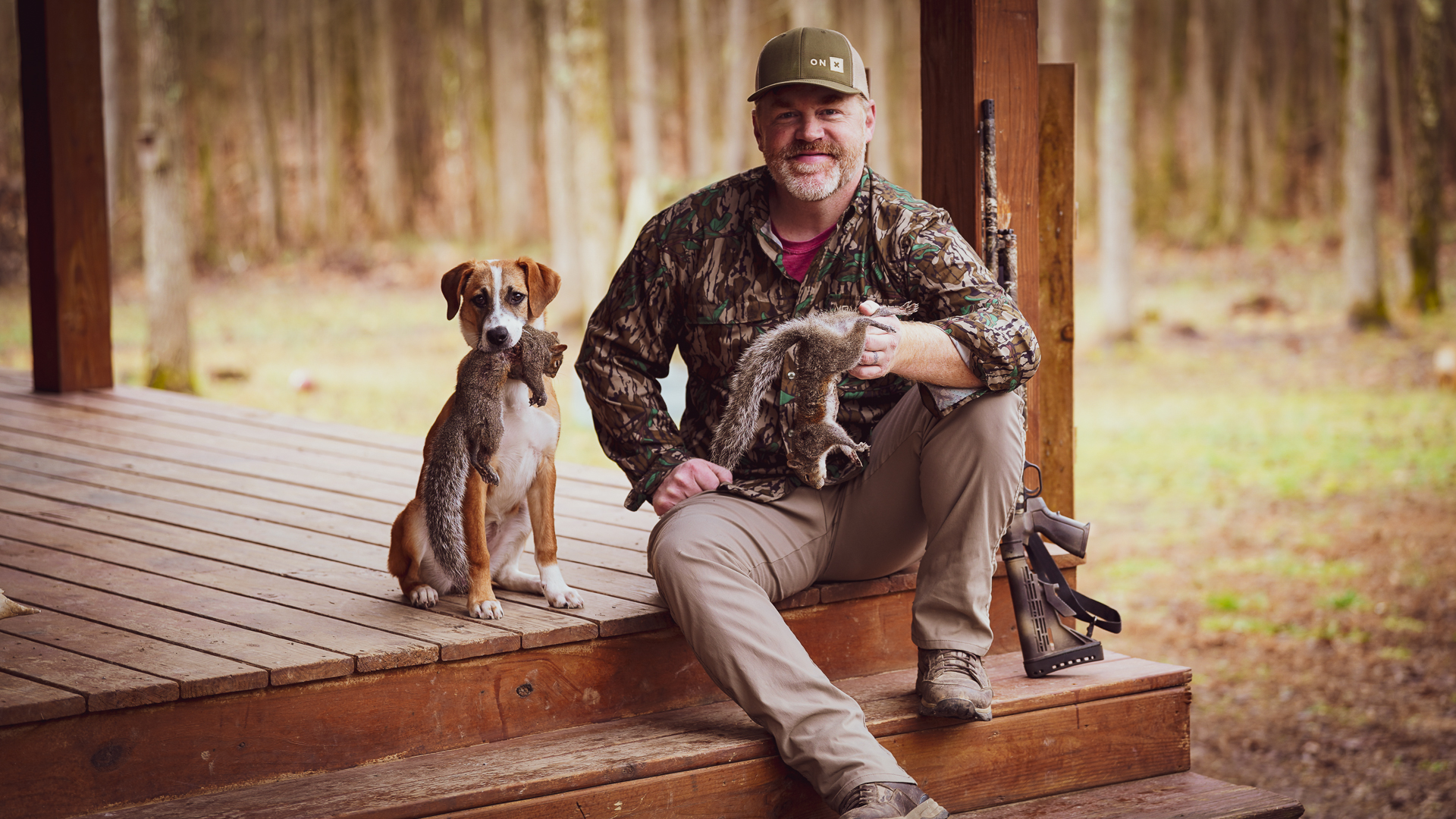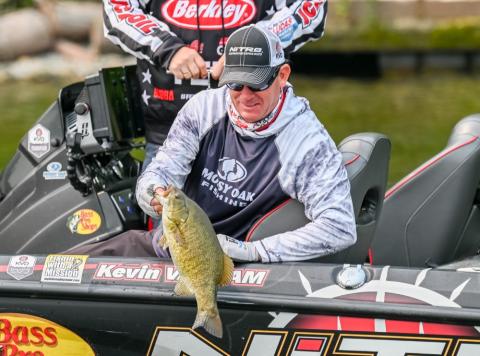Pictured: Cricket's first squirrel.
Written by Brodie Swisher
Dig back far enough, and you’ll find my hunting roots are grounded in squirrel hunting with my dad. That’s where it all started for me, one early fall morning, many years ago. Since that time, deer and turkey hunting found their place among my favorite hunting pursuits each year.
However, as I now raise kids of my own, the revival of my squirrel hunting desire has grown stronger than ever. And while we still favor early season squirrel hunting among the hickory trees, hunting with a squirrel dog rounds out our season and keeps us in the woods in pursuit of bushy-tails more than ever these days.
The latest squirrel pup we’ve added to the mix is a Mountain Cur we call, Cricket. She was a leftover from a litter I found in Arkansas just after Christmas in 2022. I made the drive across the Mississippi River, from Tennessee to Arkansas, to meet up and haul the pup back to meet my family.
After spending a few days wrapping up the Christmas season and kicking off the New Year, it was time to get to work and introduce Cricket to the squirrel woods. Day 1 of training began in the first week of January. Little did we know, just 30 days later, we’d shoot our first squirrel out to her that she’d trailed, treed, barked and retrieved. Read on for a look at how we trained our pup to tree squirrels in 30 days.
The Introduction to Squirrels

Pictured: Cricket treeing a squirrel.
I wanted Cricket to see, smell, and taste her first squirrel as quick as I could possibly make an introduction happen. I wanted my pup to imprint on squirrels as early as possible. The beauty of squirrel dog training is that squirrels can be found most anywhere. To expedite the process, I took her to the local park where squirrels run rampant. When I pulled up in the parking lot, there were squirrels on the ground just 10 yards from my truck.
With Cricket in my lap in the front seat, I directed her attention to the closest squirrel perched on top of a trash can. She looked, but much to my disappointment, didn’t express much excitement. I tried to fire her up with my excited voice, and even gave her a boost of encouragement, as I cast her toward the unsuspecting squirrel. But she really had a couldn’t care less attitude about the encounter. I immediately questioned whether or not I had a keeper in my new pup.
On the way home from the park, I came across a freshly-killed squirrel in the road. I made an abrupt stop and snatched it from the middle of the road. It was a gift from the Lord, I thought, as I quickly threw it in the floorboard and jumped back in the truck.
When we got back home, I strung the squirrel up in a tree about 5 feet off the ground and called Cricket to come investigate. She immediately keyed in on the dead squirrel and did everything she could to get it in her mouth. She jumped on the tree, whined, whimpered and barked. My concern quickly turned to optimism as we seemed to have sparked an interest for squirrels in our new pup.
Introduce your pup to a squirrel early. Let them see it, smell it and taste it. Once the introduction is made, it’s time to turn them loose to find it for themselves.
Daily Consistency

Pictured: Cricket and the author, Brodie.
One of the biggest commitments my family made in the training of this new pup was to make the training regimen a daily routine. With pups in the past, I simply took them out for training when I had time. The sessions would typically come once or twice a week. This time, however, I would carve out time every day for the training of Cricket.
The next day I took Cricket to some public land ground to give her room to roam and avoid a testy encounter with the little old ladies feeding squirrels at the park. A few minutes after we walked away from the truck, Cricket darted towards the woods. A squirrel scrambled up to the first limb of a short tree and started barking at the intrusion by the pup. Cricket sat at the base of the tree and watched the raucous without making a sound.
A short walk later and she saw another squirrel deep in the woods hopping from tree to tree. Cricket took off and covered 50-60 yards before the squirrel made its retreat. Despite not barking at the tree, Cricket had treed her first squirrels in the wild. The God-given prey drive within our pup was quickly coming out.
Carve out time every day to get your pup in the woods. There’s no magic to the training process. Ask any veteran squirrel dog man and he’ll tell you, the key to training a pup is to put boots on the ground as much as possible. Time in the woods is the best teacher.
We started Cricket in the woods the first week of January at 3 ½ months old. She never missed a day in the woods over the next month. The first week of February, she treed a squirrel on our farm while hunting with my boy, Aidan. He shot a big fox squirrel out to her that day, and she’s continued to put squirrels in the tree every hunt since.
Keep Them in The House or Kennel?
The outside kennel is where most squirrel dogs eat, sleep and await their next trip to the woods. Cricket is an exception to the rule. She’s a house dog. She doesn’t have free run of the house, but she’s got her little corner where she hangs out and keeps an eye out the back door for any squirrels in the yard. Sure, this routine may not work for the competition squirrel dog hunter. But that’s not Cricket. She’s simply a pleasure dog – a meat hunter – for my family to enjoy.
Keeping her in the house makes her more a part of the family and a part of the daily routine. It makes the training process much easier and far more consistent as I can interact, communicate, and drop commands on her throughout the day. Again, it’s not for everyone. These dogs are high energy. But having them in the house gives you the opportunity to instill and demand the behavior and obedience you want out of your pup, much like you would a child living in the home.
Training a Squirrel Dog To-Do List
Start Them Early – Whether your training process begins at 6 weeks, or 6 months, the key is to let them imprint on what they were born to do as early as possible. Keep some squirrel tails handy for your young pup as a teaser to spark the interest.
Spend Time in the Woods Daily – Make it a daily routine to get your pup in the woods. It doesn’t have to be a long hike. Just make it a daily routine of letting their eyes, ears, and nose begin the process in the squirrel woods. The local park can be a great place to help your dog discover the squirrel drive within them.
Build Obedience Skills – Don’t get so focused on squirrel skills that you blow past the need for basic obedience training. Your pup needs to know and adhere to the basics of obedience.
Keep it Fun and Exciting – Your pup is much like a child. They can be super sensitive and well aware of when you’re not happy. Patience is the key to the process here. Keep things fun and exciting, and your pup will stay engaged. Unleashing your hot temper on a pup can do more harm than you might think.
Use a Training Collar – There will be times and stages in your pup’s life when they will test you - again, much like a child. They must learn who the boss truly is. The training collar allows you to build obedience within your pup; to quickly establish a respect for the commands you expect. The Garmin Alpha 200i is hard to beat when it comes to a training collar that allows you to always know the whereabouts of your pup, as well as deliver all levels of control, regardless of range. It’s the ultimate tool for the tracking and training process of your pup once it begins to range out.
Final Thoughts
Again, patience can’t be stressed enough. Long-time dog men will often tell you that a squirrel dog finds its stride at 2 years old. The waiting game can truly be the hardest part. The steps mentioned above will help you expedite the process. They are the steps we used to take Cricket from zero experience in the squirrel woods, to consistently treeing and killing squirrels in just 30 days.



























